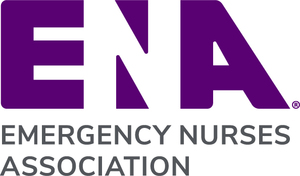SCHAUMBURG, Ill., Aug. 24, 2020 /PRNewswire/ -- New research conducted by the Emergency Nurses Association explores secondary traumatic stress in emergency nursing and its impact on nursing practice and workplace environment.
The study, "Traumatic stress in emergency nurses: Does your work environment feel like a war zone?" will be published in the September issue of International Emergency Nursing.
"The results of this study are a big step forward for the nursing community in recognizing the levels of secondary traumatic stress in nurses as well as its impact on their overall lives," said lead researcher and Director of ENA's Institute for Emergency Nursing Research Lisa Wolf, PhD, RN, CEN, FAEN. "We hope that this research can lead to the development of ENA resources that will help nurses, managers and departments recognize STS and implement mitigating practices."
Wolf and fellow researchers conducted the study during hour-long focus groups at Emergency Nursing 2019, ENA's annual education conference. A total of 53 nurses who participated in the study offered sobering insights about STS, including impaired sleep and functionality, feeling depressed, disengagement from their lives and actively avoiding anxiety-triggering treatment spaces and patient populations in the ED. Common observations among participants included other symptoms such as paranoia, hypervigilance, heart palpitations and anxiety, nightmares and flashbacks.
As a result of these findings, the research also uncovered that STS affected patient care, the ability to recognize deteriorating health signs, escalating violence in patients and increased suicidality in the profession. There is compelling evidence that it is part of a cycle of relational violence within the profession that has devastating consequences for both nurses and patients.
Participants offered a variety of solutions and a positive outlook for the future of STS in emergency nursing by recommending opportunities to decompress, participate in better training and preparation for dealing with trauma, PTSD and STS, and disconnecting from stress inducing situations throughout the day.
"The Emergency Nurses Association is proud to be one of the leaders in emergency nursing research and although this study was conducted in 2019, the findings are particularly relevant in 2020 given the high-stress environments COVID-19 has put us into," said ENA President Mike Hastings, MSN, RN, CEN. "In addition to the STS factors found in 2019, emergency nurses are now experiencing high-risk environments, PPE shortages, job loss and overall stress brought on by the pandemic. With this research, we can forge ahead in creating tools, resources and outlets to reduce secondary traumatic stress among emergency nurses."
The study is currently available online and will be published in September.
About the Emergency Nurses Association
The Emergency Nurses Association is the premier professional nursing association dedicated to defining the future of emergency nursing through advocacy, education, research, innovation, and leadership. Founded in 1970, ENA has proven to be an indispensable resource to the global emergency nursing community. With nearly 50,000 members worldwide, ENA advocates for patient safety, develops industry-leading practice standards and guidelines, and guides emergency healthcare public policy. ENA members have expertise in triage, patient care, disaster preparedness, and all aspects of emergency care. Additional information is available at www.ena.org.
ENA Media Contact:
Dan Campana
Senior Manager, PR & Communications
847-460-4017
[email protected]
SOURCE Emergency Nurses Association

Related Links
WANT YOUR COMPANY'S NEWS FEATURED ON PRNEWSWIRE.COM?
Newsrooms &
Influencers
Digital Media
Outlets
Journalists
Opted In




Share this article